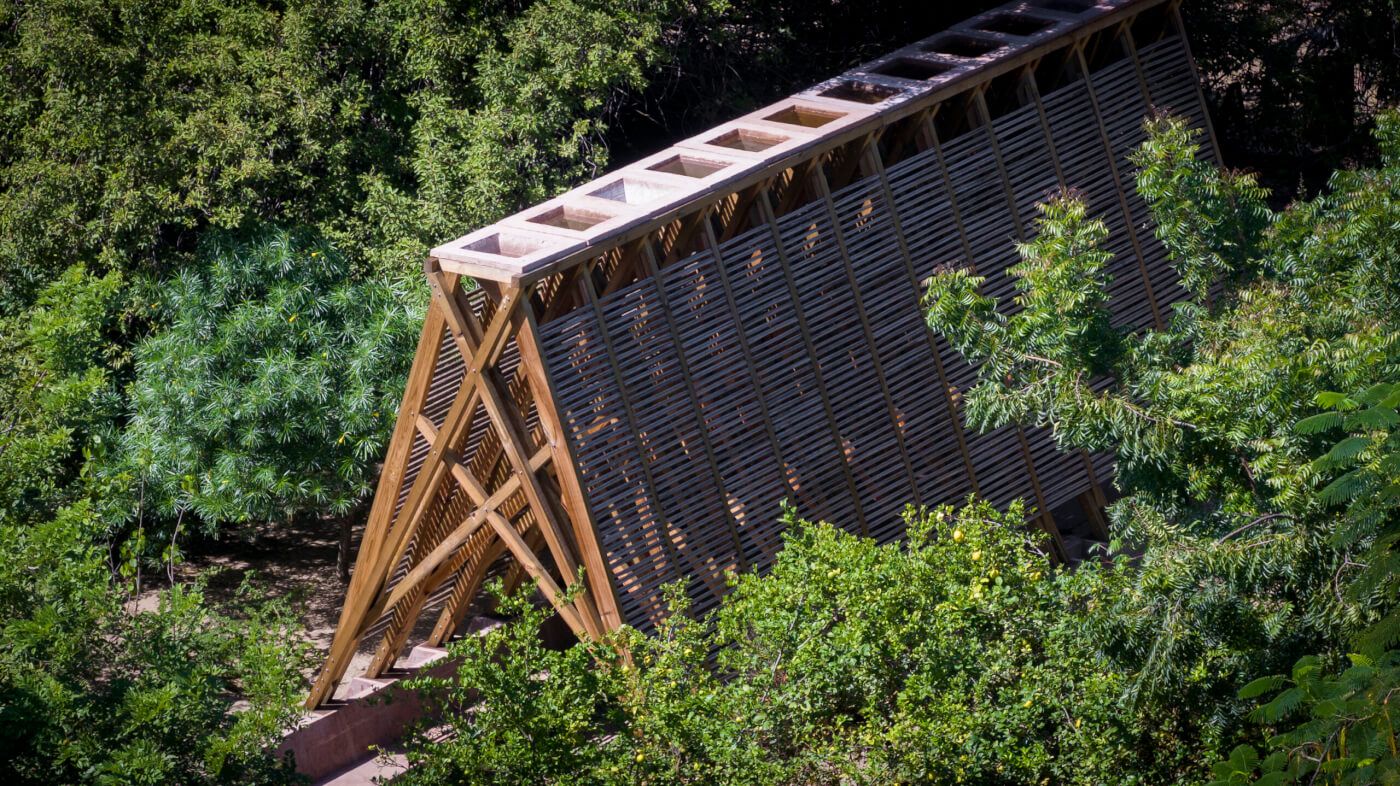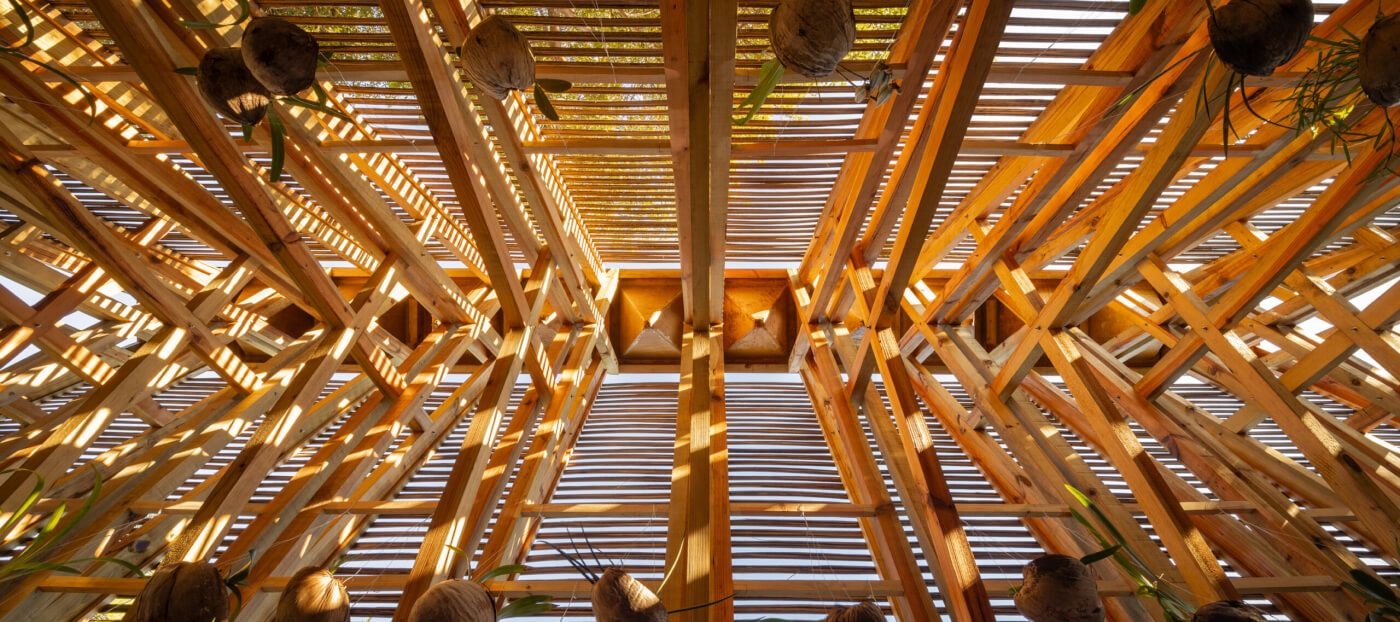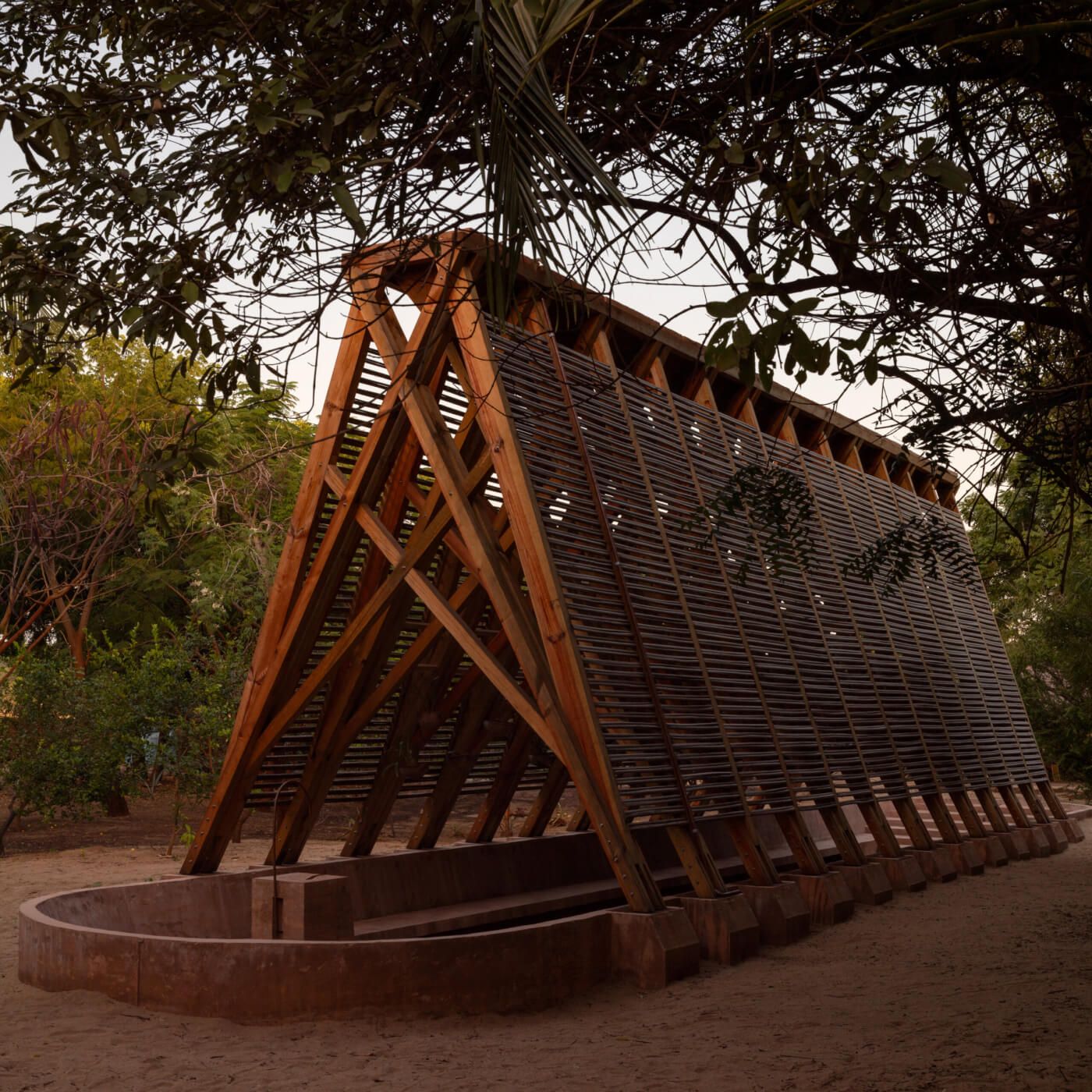Orchid pavilion | Bernardo Quinzaños
2023
The Orchid Pavilion, designed for Casa Wabi and inaugurated on February 3rd, 2024, is located
on the outskirts of Puerto Escondido, between the sea and the mountains. It is a wooden structure, permanent, sustainable, and lightweight, dedicated to the conservation of orchids in the Oaxaca region, which highlights the strong relationship between the biological and cultural diversity of the landscape.
As we approached the design of the Orchid Pavilion at Casa Wabi, our research pointed towardsome clear technical features, components, and facts. It became evident that in order to grow, reproduce, and collect orchids, we needed to create the right environment for them to thrive:humid, partially shaded, and well-ventilated.
But more interestingly, the relationship between the Japanese philosophy of Wabi-Sabi, whichbelieves that beauty and harmony are found in simplicity, imperfection, and unconventionality,and the rich and complex traditions of the Oaxacan coast—its vernacular, locally sourcedmaterials, and the high quality of the artisanal works of the local craftsmen—were to be at thecenter of our proposal. Then, unexpectedly, we thought of the Japanese word Ikigai.
Ikigai (生き甲斐, ‘a reason for being‘) could be roughly translated as the happinessof being busy. The term combines two Japanese words: iki (生き, meaning ‘life oralive’) and kai (甲斐, meaning ‘an effect, result, fruit, or worth’), resulting in‘a reason for being alive’.
When somebody finds their purpose, their calling, they are more likely to lead a long, healthy life.However, it’s easy to get lost in the stress and noise of our daily routine, so we need to makespace, we need to chill out,in this case, with the orchids.
When you enter the pavilion, you breathe in the humidity, hear the gentle drops falling, feel thecrossing winds, and hopefully, you will be able to remember who you are, what your reason forbeing is. What is your Ikigai.
Our pavilion focuses on three main elements:
Firstly, the pavilion is a simple and austere machine. Twelve clay-based humidifiers utilize gravityto create a humid environment within the structure that houses orchids from the Oaxacan coast.
Secondly, the pavilion employs simple construction materials and techniques, including locallysourced wood and custom-made clay ceramic pieces baked in high-temperature kilns.
And thirdly, the pavilion serves as a sanctuary for the orchids while also aiming to evoke aprofound sense of Ikigai in its visitors.
The main element that allows orchids to thrive is a humid environment. The intricate roots,branches, and leaflets gather water from the air, soil, and all surfaces. A series of pyramid-shaped,water-filled clay basins rests at the top of a simple wooden structure. The basins slowly filter tinydroplets of water that fall to the ground, allowing for drip irrigation. The water is collected by clay-based trays that remain permanently humid. The breeze and heat enable the orchids to drinkwater directly from the environment, eliminating the need for manual watering of the specimens.
“Life is the essence of wetness, and wetness is the essence of beauty”-Derek Zoolander
To the guests of Casa Wabi, the orchid pavilion offers a refuge to sit and drink water after a longwalk. Remembering that the first steps of humanity occurred in the shade of a tree, the pavilion also communicates a contemplative journey, as the water people drink is the same water orchids drink.
The sound of dripping in the bowls resonates with different natural cycles and human activity.This cool, semi-submerged space changes the horizon and perspective of visitors as theydescend to ground level, allowing them not only to appreciate the diversity of orchid species butalso to connect with the humble root of life in a state of harmony.
on the outskirts of Puerto Escondido, between the sea and the mountains. It is a wooden structure, permanent, sustainable, and lightweight, dedicated to the conservation of orchids in the Oaxaca region, which highlights the strong relationship between the biological and cultural diversity of the landscape.
As we approached the design of the Orchid Pavilion at Casa Wabi, our research pointed towardsome clear technical features, components, and facts. It became evident that in order to grow, reproduce, and collect orchids, we needed to create the right environment for them to thrive:humid, partially shaded, and well-ventilated.
But more interestingly, the relationship between the Japanese philosophy of Wabi-Sabi, whichbelieves that beauty and harmony are found in simplicity, imperfection, and unconventionality,and the rich and complex traditions of the Oaxacan coast—its vernacular, locally sourcedmaterials, and the high quality of the artisanal works of the local craftsmen—were to be at thecenter of our proposal. Then, unexpectedly, we thought of the Japanese word Ikigai.
Ikigai (生き甲斐, ‘a reason for being‘) could be roughly translated as the happinessof being busy. The term combines two Japanese words: iki (生き, meaning ‘life oralive’) and kai (甲斐, meaning ‘an effect, result, fruit, or worth’), resulting in‘a reason for being alive’.
When somebody finds their purpose, their calling, they are more likely to lead a long, healthy life.However, it’s easy to get lost in the stress and noise of our daily routine, so we need to makespace, we need to chill out,in this case, with the orchids.
When you enter the pavilion, you breathe in the humidity, hear the gentle drops falling, feel thecrossing winds, and hopefully, you will be able to remember who you are, what your reason forbeing is. What is your Ikigai.
Our pavilion focuses on three main elements:
Firstly, the pavilion is a simple and austere machine. Twelve clay-based humidifiers utilize gravityto create a humid environment within the structure that houses orchids from the Oaxacan coast.
Secondly, the pavilion employs simple construction materials and techniques, including locallysourced wood and custom-made clay ceramic pieces baked in high-temperature kilns.
And thirdly, the pavilion serves as a sanctuary for the orchids while also aiming to evoke aprofound sense of Ikigai in its visitors.
The main element that allows orchids to thrive is a humid environment. The intricate roots,branches, and leaflets gather water from the air, soil, and all surfaces. A series of pyramid-shaped,water-filled clay basins rests at the top of a simple wooden structure. The basins slowly filter tinydroplets of water that fall to the ground, allowing for drip irrigation. The water is collected by clay-based trays that remain permanently humid. The breeze and heat enable the orchids to drinkwater directly from the environment, eliminating the need for manual watering of the specimens.
“Life is the essence of wetness, and wetness is the essence of beauty”-Derek Zoolander
To the guests of Casa Wabi, the orchid pavilion offers a refuge to sit and drink water after a longwalk. Remembering that the first steps of humanity occurred in the shade of a tree, the pavilion also communicates a contemplative journey, as the water people drink is the same water orchids drink.
The sound of dripping in the bowls resonates with different natural cycles and human activity.This cool, semi-submerged space changes the horizon and perspective of visitors as theydescend to ground level, allowing them not only to appreciate the diversity of orchid species butalso to connect with the humble root of life in a state of harmony.





